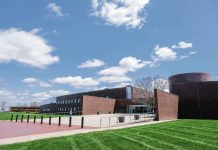The city of Columbus is looking at steps that would reduce carbon pollution in Columbus.
For starters, the city engineering department plans to study all city-controlled stoplights starting with Central Avenue and State Street, said Dave Hayward, executive director of public works/city engineer.
If lights can be timed more efficiently, cars will spend less time idling at intersections, Hayward said. As a result, carbon emissions should go down.
This conclusion is supported by numerous university studies on the impact of efficient signal timing on emission of greenhouse gases such as carbon dioxide.
One study published in the Transportation Research Journal found that well-timed stoplights can reduce carbon emissions by as much as 50 percent. A similar study from the U.S. Department of Transportation found carbon reductions of up to 22 percent in several areas which implemented thorough signal retiming programs.
According to these studies, the most significant reductions come from periods of acceleration between stoplights. The Transportation Research Journal study found cars emit up to 350 percent more carbon pollutants while accelerating than while cruising at a steady speed.
Some of the busier stoplights in town are not under city control, however, Hayward said.
For example, many of the stoplights along State Road 46 and U.S. 31 fall under the jurisdiction of the Indiana Department of Transportation. While he would like to see these included in city signal planning, this is dependent on cooperation with the state.
In the long term, the city plans to focus on improving alternative transportation options which will allow some residents to move away from driving as their primary mode of transportation, Hayward said.
He points to comprehensive planning documents from the city which call for trail and sidewalk improvements aimed at allowing better pedestrian and bike access from underserved areas of the city. Ideally, these additions would allow residents to walk and bike to many destinations without driving, Hayward said.
Mitigating pollution from cars is one of the top priorities of this project, along with improving public health and beautifying the city.
Particularly, there is no access to existing People Trails in a triangle covering the southeast side of Columbus bound by Haw Creek to the west and Tenth and State streets to the north and south. The only access in this area is an isolated loop in Clifty Park, which does not connect to any other portion of the trail.
A study conducted as part of comprehensive city planning found strong demand for practical access from pedestrian and bicycle paths. More than 88 percent of respondents indicated that they would rely on walking if it were practical, while 86 percent said they would rely on biking if it were a practical alternative to driving.
Many residents say they already use bikes as an alternative to driving. Nearly half of all those surveyed reported regularly using a bicycle for purposes other than recreation or exercise, primarily commuting, shopping and traveling to and from school.
[sc:pullout-title pullout-title=”Commuting characteristics for Columbus” ][sc:pullout-text-begin]
Total number of daily commuters: 21,484
Total commuting alone: 18,122
Total carpooling: 2,075
Total regularly using public transportation: 150
Total percentage commuting less than 10 minutes per day: 22 percent
Total percentage commuting 10 to 14 minutes per day: 21 percent
Total percentage commuting 15 to 19 minutes per day: 21 percent
Total percentage commuting more than 20 minutes per day: 2 percent
Average daily commute in minutes: 17.5 minutes
Source: U.S. Census Bureau American Fact Finder Report 2014
[sc:pullout-text-end]




